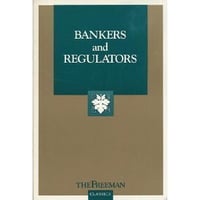
Bankers and Regulators - Hans F. Sennholz
“Money is different,” we are told by practically every member of the economics profession, including many who stand tall against government intrusion in every other sector of the economy. This difference, in their eyes, legitimizes government provision and control of money as well as its regulation of those private institutions which create and lend money. The contrib utors to Bankers and Regulators, the eighth volume in the Freeman Classics series, however, find that line of reasoning unpersuasive. So will the reader of this book, when faced with its revelations of not only the adverse consequences of those regulations but also of successfully applied alternatives to government regulation.
The book consists of a lengthy introduction and seventeen articles, all of which, at one time or another, appeared in The Freeman. While one (a William Cullen Bryant piece critiquing usury laws) was written in 1836, most are of recent vintage, with over three quarters of them first published within the last ten years. The age of the pieces in this collection is of little consequence, as they are based on principles which remain as valid today as when they were first written.
Bankers and Regulators is divided into three sections, which roughly correspond to theory, history, and policy prescriptions. By no means are these divisions airtight, however, as many selections provide the reader with all three. Hans Sennholz’s article on the bailout of the savings and loan industry is a prime example. The longest piece in the collection, it is an extended narrative for which his mastery of economic theory furnishes a coherent explanation. How cartels inevitably break down, the distortions created by inflation, the moral hazard entailed by government “insurance” which defies every principle of insurance, and the ever-destructive impact of price controls (in this case on interest rates) are all clearly illustrated by the events described here.
In addition to the topics mentioned above, the international monetary system and credit crisis (Ken S. Ewert, Christopher Culp), fractional reserve banking (Morris Markowitz), abolition of the Fed (Ernie Ross, Elgin Groseclose), deposit insurance (Jeffrey Rogers Hummel, Kurt Schuler), free banking (Lawrence H. White, Donald R. Wells, and L.S. Scruggs), the gold stan dard (Joe Cobb), and electronic banking (Elizabeth Kolar) each rate at least one chapter of this collection. The volume is strong on history, making it suitable as a supplementary text in money and banking courses, texts for which almost never contain enough historical material for my taste. It is also infused with FEE’s principled position that free markets are desirable for both practical and moral reasons. The reader of this volume will be well equipped to defend the position that money is no exception to the general case for free markets.
Robert Batemarco
Format: Paperback
Number of pages: 176
Year of publication: 1993
ISBN: 9780910614917